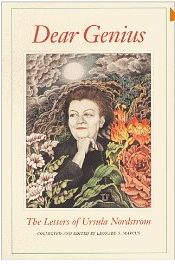“A generation ago, there was no general conspiracy among writers to protect children.”

Books, The New Yorker, December 7, 1946, p. 127
Katharine S. White on Gods and Heroes of Ancient Greece (Pantheon Fairy Tale & Folklore Library):
Of course, much of it is strong medicine and not for young children. But after many weeks of my reading, or at least looking into, several hundred careful, loving, protective, prettily illustrated juveniles, this book of gods and heroes at last seems the real thing.
It is common gossip among the experts in children’s reading—the teachers, the librarians, the critics—that the child of today is a lucky little fellow. Children, say these experts, no longer need be frightened, as their parents were, by grim and brutal fairy tales and by generally unsuitable reading matter. And there is great rejoicing over the abundance of well-illustrated, well-printed books that appear each season. The flowering of children’s literature and graphic art is usually attributed ot the influence of the children’s-book departments in the great city libraries. It is certainly true that there are scores of beautiful, innocuous books, but I’ve begun to wonder whether the sheer quantity of them does not divert children from adult books they otherwise would be reading. I wonder, too, whether our children, immersed in the protective bath of modern psychology, may not be worse off than were their elders without it. The child has become sacrosanct, and, by extension, so has the children’s book. This was made clear to me some time ago at a candlelit meeting at which children’s books were discussed in a spirit of reverent dedication. Like the experts at that gathering, many writers are careful never to approach the child except in a childlike manner. Let us not overstimulate his mind, or scare him, or leave him in doubt, these authors and their books seem to be saying; let us affirm. Somehow, this modern sentimentality seems to me far more insidious than the simpleminded sentimentality of the Victorians. At any rate, the Pantheon book of myth is a good antidote.
That was in 1946. Sendak hadn’t come along yet. (His first published illustrations appeared in a textbook in 1947; his first children’s book, Kenny’s Window, came along in 1956, and the deliciously dark Pierre: A Cautionary Tale, part of the Nutshell Library, in 1962.) Ursula Nordstrom was busily changing the shape of children’s lit in a way I gather Mrs. White approved of—veering away from saccharine morality tales toward immersive, imaginative adventures. What would be fun to see is Katharine White’s take on the prevalence of edgy, black-humor-based books in today’s market: creators like Lemony Snicket and Jon Klassen come to mind. I suspect she’d enjoy their work.
Mrs. White goes on to wax nostalgic about her own childhood encounters with Ivanhoe, Oliver Twist, and David Copperfield (“I made my first inquiry into the mystery of birth because of the puzzling phrase on the first page: ‘I was born with a caul.'”) and then remarks that publishers seemed afflicted with the same nostalgia, given the number of classic reprints on their lists. Alas, she reports,
“No publisher has thus far reissued the set of books I read oftenest—the Andrew Lang collections of folk and fairy tales known to my generation as ‘the colored fairy books.’ I owned the Blue, the Red, the Green, the Yellow, the Pink, the Grey, and the Violet.”
Originally published in the late 1800s/early 1900s, these collections were back in print during my own 1970s/80s childhood, and I hunted the various shades of the rainbow in every Aurora, Colorado library branch within biking distance of my parents’ house. I still have my treasured paperback copies of the Blue Fairy Book and the Green Fairy Book, which have made their dogeared way through my children. Nowadays, the Lang fairy books have reappeared as mainstays of legions of Charlotte Mason-inspired homeschoolers, and just last week I uploaded a copy to my Kindle, the better to enjoy its charms (augmented by enlargeable font) with Rilla.
A handful of the new books Mrs. White reviews in this 1946 column are still with us, prized among the kidlit enthusiasts and living-books homeschoolers—Miss Hickory, Justin Morgan Had a Horse, d’Aulaire’s Pocahontas (“an unqualified delight,” she says, unaware of the many qualifications a 21st-century audience would pile onto it—though not nearly as many as necessitated by d’Aulaire’s Leif the Lucky, whose ending recently made me wince and end the read-aloud a couple of pages early)—but most of the season’s new offerings are titles unfamiliar to me, including books by Lois Lenski and Garth Williams.
Katharine White’s children’s-book reviews are almost as much fun as her gardening columns, and if you have access to the New Yorker digital archive, it’s worth your time to pop in and read her take on a selection of books that have, for the most part, come and gone.



